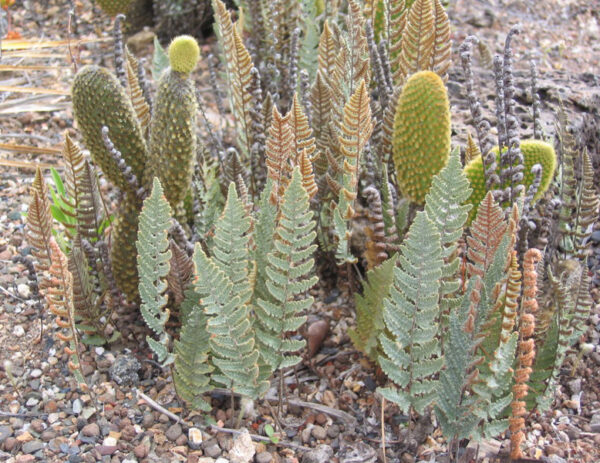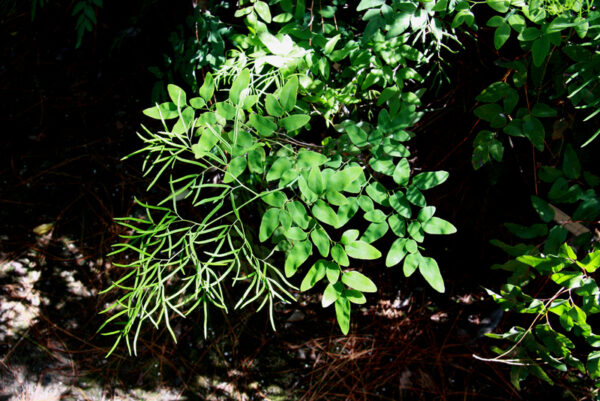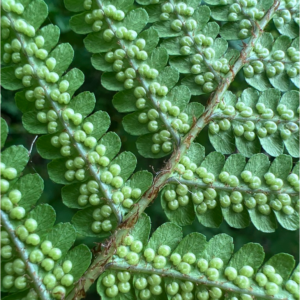Most people are familiar with ferns at some level, whether it’s their iconic, finely divided foliage or the varied palette of green that our native sword ferns lend to California redwood forests. As non-flowering plants, ferns are often considered filler or background, much like those other non-flowering garden staples, conifers. But also like conifers, ferns are a diverse and often beautiful group found in many different habitats around the world. Their fronds vary from the lacy elegance of maidenhair ferns to the bold and undivided blades of hart’s tongue fern. With a complex life cycle, ferns are biologically interesting, and well worth closer consideration as garden plants.
The Garden has an outstanding collection of ferns and one that was recognized for its scope and high standard of care by the Plant Collections Network. Ferns are woven into the tapestry of our habitat-based planting scheme, and we have for many years added them in line with our goal of representing as broad a range of taxonomic diversity as possible in our collection. Tropical ferns are displayed in the Orchid, Fern and Carnivorous Plant House and Tropical House, and aquatic ferns are presented in the Aquatic Plant Display. In nature ferns make up an important component of many habitats, from the tropics through temperate regions, from deserts to rainforests, and from fully aquatic to epiphytic life zones. They range in size from the giant tree ferns of our Australasian Area to tiny floating plants that you would be hard-pressed to identify as a fern, such as the mosquito fern (Azolla spp.) found on the surface of most of the Garden’s ponds.
The Plant Collections Network and the Collection by the Numbers
The Garden has over 400 accessions of 310 taxa of ferns. About 65% grow in the outdoor collections, and about 84% are of known wild origin, making them particularly valuable research specimens.
The Garden has benefited greatly from the curatorial support of Dr. Alan Smith, retired Curator of Pteridophytes at the UC & Jepson Herbaria and former member of the Garden’s Faculty Advisory Committee. Dr. Smith is the author of Tropical Ferns of Mexico and is an internationally recognized expert in fern systematics and taxonomy. Over twenty published research papers have been based in part on the Garden’s fern collection; twelve of these are authored or co-authored by Dr. Smith. Please see our Research Publications page for the complete listing.
In 2012 the Garden’s fern collection was recognized as a collection of national significance by the Plant Collections Network (PCN). The PCN is a joint program of the American Public Gardens Association and the USDA’s Agricultural Research Service. The program recognizes excellence in plant germplasm preservation and plant collections management. https://www.publicgardens.org/programs/about-plant-collections-network
Looking for a specific fern? Check our plant database.
Dry-growing or Xerophytic Ferns

Cheilanthes lindheimeri in the Deserts of the Americas
We commonly associate ferns with moist habitats, but one of the most notable aspects of the Garden’s collection is the assemblage of dry-growing or xerophytic ferns found in the Xerophytic Fern Display., located along the side of the Arid House, and in several biogeographic collections. These ferns are from arid regions of California, deserts of the New World, and from southern Africa. Represented genera include Myriopteris, Pellaea, Aspidotis, Astrolepis and Notholaena. These xerophytes have special adaptations that allow them to prosper in otherwise inhospitable habitats, such as special hairs or scales on the leaves to help stem water-loss, the ability to go dormant in dry times and to respond rapidly to limited seasonal rainfall.
Xerophytic species native to California demonstrate that ferns can prosper in the summer dry climate of the state, and should be considered as part of our native plantings. While not strictly considered xerophytes, the familiar polypody ferns of California cope with our summer-dry climate by going fully dormant when the rain stops, then springing into growth with the first rains of autumn. Sue Olsen’s book, Encyclopedia of Garden Ferns (2007) features images of xerophytic and other ferns from the Garden collection.
Tree Ferns

Approach to the Australasian Area (photo by Stephen Woo)
Several other Garden areas host outstanding collections of ferns. Tree ferns (Cyathea, Sphaeropteris, Dicksonia) native to New Zealand and Australia create a striking display at the approach to the Australasian Area just beyond the Japanese Pool. Their trunks play host to epiphytic staghorn ferns (Platycerium spp.) and they are under planted with terrestrial ferns, including Sadleria cyatheoides from Maui, Hawaii! With its cool, moist climate, New Zealand is the origin of many species of ferns grown in the Bay Area. Ferns play a prominent role in Maori culture, and a fern frond is even the logo of the famous football (rugby) team, the All Blacks. With a bit of supplemental watering, ferns from New Zealand do well in our California landscape.
Another particularly choice assemblage of ferns is found throughout the Mexican and Central American Area. Mexican tree ferns of the genus Cyathea are just barely hardy in our cloud forest planting, as is the case with the few members of the otherwise tropical genus Elaphoglossum that we grow out of doors. With undivided, blade-like fronds, the genus Elaphoglossum is one of several with the common name tongue fern – indeed, the generic name translates as elephant tongue.
Members of the Family Polypodiaceae

Llavea cordifolia (Pteridaceae) was collected in Nuevo Leon, Mexico, where it grows in deep shade by a waterfall. It doesn’t need quite that wet a situation in the Garden, shown here in the Mexican/Central American Area. (photo by Holly Forbes)
Members of the family Polypodiaceae are particularly common in the Mexican and Central American Area. Allied with the familiar polypodys of California, most of the Mexican and Central American taxa are now classified in the genus Pleopeltis. These ferns can form dense but not invasive stands in shaded areas with limited moisture. Two particularly choice representatives from this area are the elegant Llavea cordifolia and the rare Mexican form of the hart’s tongue, Asplenium scolopendrium.
Ferns often add an exotic element to plantings or indoor collections. Take a walk along Strawberry Creek in the Asian Area where the bold, 5 foot tall fronds of the Japanese turnip fern, Angiopteris lygodiifolia create a startling presentation. In the Orchid, Fern and Carnivorous Plant House the range of plant sizes and frond forms is amazing. Of the over 400 accessions and 310 taxa in the garden, 65% are growing outdoors. Our collection shows that ferns grow in many habitats, often where you least expect them. They add texture and beauty to our gardens and homes, and most of us are just beginning to appreciate their potential.
Explore UC Botanical Garden Ferns in Photos

Dr. Susan Fawcett, research botanist and fern curator at the University and Jepson Herbaria strolled the Garden and shared via iNaturalist fern photos from her visit.
Pictured left: Sunset Fern (Dryopteris lepidopoda)
Photo by Dr. Susan Fawcett

